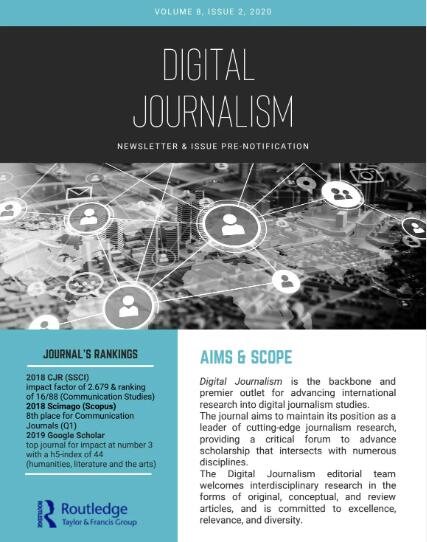The Invisible Infrastructures of Online Visibility: An Analysis of the Platform-Facing Markup Used by U.S.-Based Digital News Organizations
IF 5.2
1区 文学
Q1 COMMUNICATION
引用次数: 1
Abstract
Abstract This study analyzes and compares how the digital semantic infrastructure of U.S. based digital news varies according to certain characteristics of the media outlet, including the community it serves, the content management system (CMS) it uses, and its institutional affiliation (or lack thereof). Through a multi-stage analysis of the actual markup found on news outlets’ online text articles, we reveal how multiple factors may be limiting the discoverability and reach of online media organizations focused on serving specific communities. Conceptually, we identify markup and metadata as aspects of the semantic infrastructure underpinning platforms’ mechanisms of distributing online news. Given the significant role that these platforms play in shaping the broader visibility of news content, we further contend that this markup therefore constitutes a kind of infrastructure of visibility by which news sources and voices are rendered accessible—or, conversely—invisible in the wider platform economy of journalism. We accomplish our analysis by first identifying key forms of digital markup whose structured data is designed to make online news articles more readily discoverable by search engines and social media platforms. We then analyze 2,226 digital news stories gathered from the main pages of 742 national, local, Black, and other identity-based news organizations in mid-2021, and analyze each for the presence of specific tags reflecting the Schema.org, OpenGraph, and Twitter metadata structures. We then evaluate the relationship between audience focus and the robustness of this digital semantic infrastructure. While we find only a weak relationship between the markup and the community served, additional analysis revealed a much stronger association between these metadata tags and content management system (CMS), in which 80% of the attributes appearing on an article were the same for a given CMS, regardless of publisher, market, or audience focus. Based on this finding, we identify the organizational characteristics that may influence the specific CMS used for digital publishing, and, therefore, the robustness of the digital semantic infrastructure deployed by the organization. Finally, we reflect on the potential implications of the highly disparate tag use we observe, particularly with respect to the broader visibility of online news designed to serve particular US communities.在线可见性的无形基础设施:对美国数字新闻机构使用的面向平台标记的分析
摘要本研究分析和比较了美国数字新闻的数字语义基础设施如何根据媒体的某些特征而变化,包括其服务的社区、使用的内容管理系统(CMS)及其机构隶属关系(或缺乏)。通过对新闻媒体在线文本文章中发现的实际标记进行多阶段分析,我们揭示了多种因素如何限制专注于服务特定社区的在线媒体组织的可发现性和影响力。从概念上讲,我们将标记和元数据识别为支撑平台发布在线新闻机制的语义基础设施的各个方面。鉴于这些平台在塑造更广泛的新闻内容可见性方面发挥的重要作用,我们进一步认为,这种标记因此构成了一种可见性基础设施,通过这种基础设施,新闻来源和声音可以被访问,或者相反,在更广泛的平台新闻经济中是不可见的。我们通过首先识别数字标记的关键形式来完成分析,其结构化数据旨在使搜索引擎和社交媒体平台更容易发现在线新闻文章。然后,我们分析了2021年年中从742家国家、地方、黑人和其他基于身份的新闻机构的主页上收集的2226篇数字新闻报道,并分析了每一篇报道中是否存在反映Schema.org、OpenGraph和Twitter元数据结构的特定标签。然后,我们评估了受众关注度和这种数字语义基础设施的稳健性之间的关系。虽然我们发现标记和所服务的社区之间的关系很弱,但额外的分析显示,这些元数据标签和内容管理系统(CMS)之间的关联要大得多,在内容管理系统中,无论出版商、市场或受众重点如何,文章上80%的属性都是相同的。基于这一发现,我们确定了可能影响用于数字出版的特定CMS的组织特征,从而影响组织部署的数字语义基础设施的稳健性。最后,我们反思了我们观察到的高度不同的标签使用的潜在影响,特别是针对旨在服务于特定美国社区的在线新闻的更广泛可见性。
本文章由计算机程序翻译,如有差异,请以英文原文为准。
求助全文
约1分钟内获得全文
求助全文
来源期刊

Digital Journalism
COMMUNICATION-
CiteScore
11.20
自引率
24.10%
发文量
103
期刊介绍:
Digital Journalism provides a critical forum for scholarly discussion, analysis and responses to the wide ranging implications of digital technologies, along with economic, political and cultural developments, for the practice and study of journalism. Radical shifts in journalism are changing every aspect of the production, content and reception of news; and at a dramatic pace which has transformed ‘new media’ into ‘legacy media’ in barely a decade. These crucial changes challenge traditional assumptions in journalism practice, scholarship and education, make definitional boundaries fluid and require reassessment of even the most fundamental questions such as "What is journalism?" and "Who is a journalist?" Digital Journalism pursues a significant and exciting editorial agenda including: Digital media and the future of journalism; Social media as sources and drivers of news; The changing ‘places’ and ‘spaces’ of news production and consumption in the context of digital media; News on the move and mobile telephony; The personalisation of news; Business models for funding digital journalism in the digital economy; Developments in data journalism and data visualisation; New research methods to analyse and explore digital journalism; Hyperlocalism and new understandings of community journalism; Changing relationships between journalists, sources and audiences; Citizen and participatory journalism; Machine written news and the automation of journalism; The history and evolution of online journalism; Changing journalism ethics in a digital setting; New challenges and directions for journalism education and training; Digital journalism, protest and democracy; Journalists’ changing role perceptions; Wikileaks and novel forms of investigative journalism.
 求助内容:
求助内容: 应助结果提醒方式:
应助结果提醒方式:


